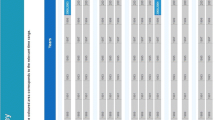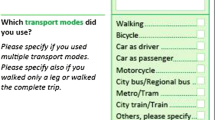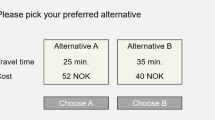Abstract
The main research question addressed by this study is to what degree individuals would change travel modes, time allocation and activity patterns after experiencing large changes in generalized transportation costs and how they would react regarding their longer-term ownership in mobility tools, assessing suppressed demand effects from an activity-based perspective. The empirical basis is a multi-day travel and online diary that is required to obtain the personalized reference values for the later stated choice and stated adaptation tasks. This paper provides first detailed information of the survey methods, recruitment and fieldwork. An initial investigation of the data and its quality attributes, descriptions of the sampling structure and response behavior are presented. Participation choice models indicate that a high incentive level leads to a higher participation rate, but the net-effect on completing the survey is zero: once recruited, higher incentives also lead to a higher drop-out incidence. Certain socioeconomic characteristics are consistently overrepresented in the sample: season ticket ownership, better education and higher income strongly increase participation and completion of the survey. Findings reveal saliency effects, whereby response behavior is influenced by the respondents’ interest in the survey topic. While general fatigue effects can only be detected for the number of reported online activities, better educated and car-less respondents exhibit an increased reporting behavior of trips over time. Importantly, while showing no effects on completion of the survey, higher incentives tend to increase response quality in terms of absolute levels (trips) and stability (online activities).





Similar content being viewed by others
Notes
Project website: http://postcarworld.epfl.ch/
Institute website: http://www.ivt.ethz.ch/en/institute/vpl.html
Note that in the pre-test, we asked for a 2-week reporting period, which, given the very large administrative effort and response burden, was reduced to a 1-week reporting period in the main survey.
Note that point-scores for the travel and planning diary are based on an average of 22 trips per week. Respondents could report a maximum of 40 trips per week.
Many respondents were complaining about the work load, and were facing conceptual problems with the prospective trip planning task for the second reporting week.
Note that the taxi alternative was excluded in the main survey as it was only chosen by one respondent in one choice situation.
This category also exhibits the highest E-shop** market share in Switzerland (Rudolph et al. 2015).
Durable goods expenditures, including standard electronic appliances, were part of a separate questionnaire on an aggregated yearly basis (see also Table 2) and not used for reference value calculation. If a respondent did not report any shop** trip during the multi-day reporting period, a potential shop** location was chosen offering a high variety of goods and high level of accessibility, assigning this respondent to the standard electronic appliances experiment as from a behavioral aspect it might be more problematic to postulate a travel distance to a grocery store. In addition, reference travel time and travel cost to the store were calculated for either carsharing/carpooling or public transportation. To avoid anchoring effects with respect to transportation modes, a specific mode for the in-store alternative was never explicitly mentioned.
Note that the route choice experiments were not included in the pre-test.
While asking at least one household member to conduct both interviews, in some cases multiple household members were willing to conduct the first SA experiment.
This number is referring to the conducted interviews (households that were eligible for the payment of the incentive). Note that because of technical problems with the first SA tool, some households had to be excluded from the final data set. The number of valid respondent/household observations are presented for each tool separately in “Tool I: adaptations in daily scheduling” and “Tool II: adaptations in mobility tool ownership” sections. Also note that tool II (adaptations in mobility tool ownership) was not yet available in the pre-test and that in wave III, no interviews were conducted anymore as the survey budget was exhausted.
Touring Club Schweiz: https://www.tcs.ch/
This solves the boundedness problem of the original dependent variable (the probability to participate in a survey).
See also Table 1: given average survey response durations between three (wave III) and 6 h (pre-test), the response rate was always above 52%. Note that in the pre-test, many respondents reported a general discontent regarding the high response burden, especially for stage I of the survey: while the socioeconomic questionnaires and the travel diary (although exhibiting a high response burden) worked well, data quality and response behavior of the trip planning and expenditure questionnaires were suffering. While some respondents did not understand the purpose of the trip planning task, others were overwhelmed by calculating their long-run expenditures for the different categories (communication, housing, education, etc.). To reduce the response burden in the main survey, a natural consequence was to skip and simplify some of the questionnaires to achieve a higher data quality of the remaining tasks and to reduce drop-out incidence.
To compare with the PCW sample, only a subsample of the MZ2010 is considered, limited to the Canton of Zurich.
Low education: no education, obligatory school, lower commercial school or apprenticeship. Medium education: grammar school, higher education entrance qualification, proficient diploma or professional school. High education: higher technical academy, college or university.
A major problem involved the recruitment of all eligible (older than 18 years) household members, simultaneously affecting the age distribution in the PCW sample: Although larger households are overrepresented, mostly fractions (e.g. parents or the addressed household heads) of all eligible household members actually participated in the survey.
Note that for model estimation, the medium incentive categories (70 CHF and 80 CHF) were pooled together, as their effects were not significantly different from each other.
Arguing that the Heckman estimator in such a case is problematic, Sartori (2003) derives an estimator under the assumption that the error terms in both equations are identical, which, in the traditional Heckman approach, is estimated from the data. In the current application, however, both approaches yield exactly the same results.
A slightly different interpretation is that high incentives might convince people who are actually not interested in the survey topic to participate, but when realizing the enormous response burden, they decide to drop-out.
Note that four respondents are excluded for analyzing the number of online activities. They were classified as complete, but did not fill in the online diary.
Due to the relatively low number of (independent) observations for which the incentive levels were varied (56 respondents), results have to be treated with caution.
Abbreviations
- AICc:
-
For finite sample size corrected Akaike Information Criterion
- CHF:
-
Swiss Francs (1 CHF \(\approx\) 1 US$)
- CP:
-
Carpooling
- CS:
-
Carsharing
- IVT:
-
Institute for Transport Planning and Systems at ETH Zurich, Switzerland
- MIV:
-
Motorized individual vehicles (car, motorbike)
- MPV:
-
Motorized public vehicles (carsharing, carpooling, taxi)
- MZ2010:
-
Data from the (representative) Swiss microcensus for mobility and travel behavior
- PCW:
-
Post-Car World (name of the project)
- PT:
-
Public transportation (train, bus)
- RP:
-
Revealed preference
- SA:
-
Stated adaptation
- SP:
-
Stated preference
References
Adler, T., Ben-Akiva, M.: A theoretical and empirical model of trip chaining behavior. Transp. Res. B Methodol. 13(3), 243–257 (1979)
Arentze, T., Hofman, F., Timmermans, H.: Predicting multi-faceted activity-travel adjustment strategies in response to possible congestion pricing scenarios using an Internet-based stated adaptation experiment. Transp. Policy 11(1), 31–41 (2004)
Aschauer, F., Hssinger, R., Schmid, B., Gerike, R.: Implications of survey methods on travel and non-travel activities: a comparison of the Austrian national travel survey and an innovative mobility-activity-expenditure diary (MAED). Eur. J. Transp. Infrastruct. Res. EJTIR 18(1), 4–35 (2018)
Axhausen, K.W., Zimmermann, A., Schönfelder, S., Rindsfüser, G., Haupt, T.: Observing the rhythms of daily life: a six-week travel diary. Transportation 29(2), 95–124 (2002)
Axhausen, K.W., Löchl, M., Schlich, R.: Fatigue in long duration surveys. Transportation 34(2), 143–160 (2007)
Axhausen, K.W., Ehreke, I., Glemser, A., Hess, S., Jödden, C., Nagel, K.A.S., Weis, C.: Ermittlung von Bewertungsansätzen für Reisezeiten und Zuverlässigkeit auf der Basis eines Modells für modale Verlagerungen im nicht-gewerblichen und gewerblichen Personenverkehr für die Bundesverkehrswegeplanung, FE-Projekt-Nr. 96.996/2011, BMVI, Berlin (2014)
Axhausen, K.W., Schmid, B., Weis, C.: Predicting response rates updated: a natural experiment. Working paper 1063, Institute for Transport Planning and Systems (IVT), ETH Zurich, Zurich (2015)
Becker, H., Loder, A., Schmid, B., Axhausen, K.W.: Modeling car-sharing membership as a mobility tool: a multivariate Probit approach with latent variables. Travel Behav. Soc. 8, 26–36 (2017)
Bliemer, M.C.J., Rose, J.M., Chorus, C.G.: Detecting dominance in stated choice data and accounting for dominance-based scale differences in logit models. Transp. Res. B Methodol. 102, 83–104 (2017)
ChoiceMetrics.: Ngene 1.1.2 user manual: the cutting edge in experimental design. Choice metrics. http://www.choice-metrics.com/ (2014). Last access: 13 Mar 2018
Daziano, R.A., Bolduc, D.: Incorporating pro-environmental preferences towards green automobile technologies through a Bayesian hybrid choice model. Transp. A Transp. Sci. 9(1), 74–106 (2013)
Dillman, D.A.: Mail and Internet Surveys. The Tailored Design Method. Wiley, New York (2000)
Dobler, C.: Travel behaviour modelling for scenarios with exceptional events—methods and implementations. Ph.D. thesis, ETH Zurich, Zurich (2013)
Doherty, S.T., Miller, E.J.: A computerized household activity scheduling survey. Transportation 27(1), 75–97 (2000)
Erath, A., Axhausen, K.W.: Long term fuel price elasticity: effects on mobility tool ownership and residential location choice. Research report, Swiss Federal Office of Energy (SFOE), Federal Office for the Environment (FOEN), IVT, ETH Zurich, Berne (2010)
Farag, S., Krizek, K.J., Dijst, M.: E-shop** and its relationship with in-store shop**: empirical evidence from the Netherlands and the USA. Transp. Rev. 26(1), 43–61 (2006)
Fröhlich, P., Axhausen, K.W., Vrtic, M., Weis, C., Erath, A.: SP-Befragung 2010 zum Verkehrsverhalten im Personenverkehr. Research report, Swiss Federal Office for Spatial Development (ARE), IVT, ETH Zurich, Berne (2012)
Galesic, M., Bosnjak, M.: Effects of questionnaire length on participation and indicators of response quality in a web survey. Public Opin. Q. 73(2), 349–360 (2009)
Golob, T.T., Meurs, H.: Biases in response over time in a seven-day travel diary. Transportation 13(2), 163–181 (1986)
Groves, R.M., Singer, E., Corning, A.: Leverage-saliency theory of survey participation: description and an illustration. Public Opin. Q. 64(3), 299–308 (2000)
Handy, S., Cao, X., Mokhtarian, P.: Correlation or causality between the built environment and travel behavior? Evidence from Northern California. Transp. Res. D Transp. Environ. 10(6), 427–444 (2005)
Hanson, T.R., Hildebrand, E.D.: Can rural older drivers meet their needs without a car? Stated adaptation responses from a GPS travel diary survey. Transportation 38(6), 975–992 (2011)
Hausman, J.A., Hall, B.H., Griliches, Z.: Econometric models for count data with an application to the patents-R&D relationship. Econometrica 52(4), 909–937 (1984)
Heckman, J.J.: The common structure of statistical models of truncation, sample selection and limited dependent variables and a simple estimator for such models. Ann. Econ. Soc. Meas. 5(4), 475–492 (1976)
Hess, S., Beharry-Borg, N.: Accounting for latent attitudes in willingness-to-pay studies: the case of coastal water quality improvements in Tobago. Environ. Resour. Econ. 52(1), 109–131 (2012)
Horni, A., Nagel, K., Axhausen, K.W.: The Multi-agent Transport Simulation MATSim. Ubiquity Press, London (2016)
Hsiao, M.-H.: Shop** mode choice: physical store shop** versus e-shop**. Transp. Res. E 45(1), 86–95 (2009)
Jäggi, B., Weis, C., Axhausen, K.W.: Stated response and multiple discrete-continuous choice models: analyses of residuals. J. Choice Model. 6, 44–59 (2013)
Jara-Diaz, S., Astroza, S.: Revealed willingness to pay for leisure: link between structural and microeconomic models of time use. Transp. Res. Rec. 2382, 75–82 (2013)
Jara-Diaz, S.R., Guevara, C.A.: Behind the subjective value of travel time savings: the perception of work, leisure and travel. J. Transp. Econ. Policy 37(1), 29–46 (2003)
Jara-Diaz, S.R., Munizaga, M.A., Greeven, P., Guerra, R., Axhausen, K.W.: Estimating the value of leisure from a time allocation model. Transp. Res. B Methodol. 42(10), 946–957 (2008)
Kitamura, R., Bovy, P.H.: Analysis of attrition biases and trip reporting errors for panel data. Transp. Res A Gen. 21(4–5), 287–302 (1987)
Kitamura, R., Mokhtarian, P.L., Laidet, L.: A micro-analysis of land use and travel in five neighborhoods in the San Francisco Bay area. Transportation 24(2), 125–158 (1997)
Le Vine, S., Lee-Gosselin, M., Sivakumar, A., Polak, J.: Design of a strategic-tactical stated-choice survey methodology using a constructed avatar. Transp. Res. Rec. 2246(1), 55–63 (2011)
Lee-Gosselin, M.E.: Scope and potential of interactive stated response data collection methods. In: Conference Proceedings, vol. 10, pp. 115–133. Transportation Research Board, Washington (1996)
Löchl, M., Axhausen, K.W., Schönfelder, S.: Analysing Swiss longitudinal travel data. In: 5th Swiss Transport Research Conference (STRC). Ascona (2005)
Mokhtarian, P.L.: A conceptual analysis of the transportation impacts of B2C E-commerce. Transportation 31(3), 257–284 (2004)
Mokhtarian, P.L., Salomon, I., Handy, S.L.: The impacts of ICT on leisure activities and travel: a conceptual exploration. Transportation 33(3), 263–289 (2006)
Mokhtarian, P.L., Ory, D.T., Cao, X.: Shop**-related attitudes: a factor and cluster analysis of Northern California shoppers. Environ. Plan. B Plan. Des. 36(2), 204–228 (2009)
Paulssen, M., Temme, D., Vij, A., Walker, J.L.: Values, attitudes and travel behavior: a hierarchical latent variable mixed logit model of travel mode choice. Transportation 41(4), 873–888 (2014)
Peterson, R.A., Balasubramanian, S., Bronnenberg, B.J.: Exploring the implications of the internet for consumer marketing. J. Acad. Mark. Sci. 25(4), 329–346 (1997)
Porter, S.R.: Raising response rates: what works? New directions for institutional research 2004(121), 5–21 (2004)
Rieser-Schüssler, N., Axhausen, K.W.: Investigating the influence of environmentalism and variety-seeking on mode choice. Transp. Res. Rec. 2322, 31–41 (2012)
Rose, J.M., Bliemer, M.C., Hensher, D.A., Collins, A.T.: Designing efficient stated choice experiments in the presence of reference alternatives. Transp. Res. B Methodol. 42(4), 395–406 (2008)
Rudolph, T., Emrich, O., Bttger, T., Kleinlercher, K., Pfrang, T.: Der Schweizer Online-Handel: Internetnutzung Schweiz 2015. Universität St, Gallen, Forschungszentrum für Handelsmanagement (2015)
Sartori, A.E.: An estimator for some binary-outcome selection models without exclusion restrictions. Polit. Anal. 11(2), 111–138 (2003)
Schmid, B., Axhausen, K.W.: Post-Car World: survey methods and response behavior in the pre-test. In: 14th International Conference on Travel Behaviour Research (IATBR). Windsor (2015)
Schmid, B., Axhausen, K.W.: In-store or online shop** of search and experience goods: a hybrid choice approach. In: 5th International Choice Modeling Conference (ICMC). Capetown (2017a)
Schmid, B., Axhausen, K.W.: A latent variable exponential family modeling approach to estimate suppressed demand effects for increasing car travel costs. In: 6th Symposium of the European Association for Research in Transportation (hEART 2017). Haifa (2017b)
Schmid, B., Schmutz, S., Axhausen, K.W.: Explaining mode choice, taste heterogeneity and cost sensitivity in a Post-Car World. In: 95th Annual Meeting of the Transportation Research Board. Washington (2016)
Schmid, B., Aschauer, F., Jokubauskaite, S., Peer, S., Hssinger, R., Gerike, R., Jara-Diaz, S.R., Axhausen, K.W.: A pooled RP/SP mode, route and destination choice model to capture the heterogeneity of mode and user-type effects. In: 5th International Choice Modeling Conference (ICMC). Capetown (2017)
The American Association for Public Opinion Research: Standard Definitions: Final Dispositions of Case Codes and Outcome Rates for Surveys. AAPOR. http://www.aapor.org (2015). Last access: 13 Mar 2018
Train, K.E.: Discrete Choice Methods with Simulation. Cambridge University Press, Cambridge (2009)
Van de Ven, W.P.M.M., Van Praag, B.M.S.: The demand for deductibles in private health insurance: a probit model with sample selection. J. Econ. 17(2), 229–252 (1981)
Weis, C.: Activity oriented modelling of short- and long-term dynamics of travel behaviour. Ph.D. thesis, ETH Zurich, Zurich (2012)
Weis, C., Vrtic, M., Widmer, P., Axhausen, K.W.: Influence of parking on location and mode choice: a stated choice survey. In: 91st Annual Meeting of the Transportation Research Board (TRB). Washington (2012)
Weis, C., Vrtic, M., Schmid, B., Axhausen, K.W.: Analyse der SP-Befragung 2015 zum Verkehrsverhalten. Research report, Swiss Federal Office for Spatial Development (ARE), IVT, ETH Zurich, Berne (2017)
Acknowledgements
The authors gratefully thank to the SNSF (Swiss National Science Foundation) for funding the Post-Car World project (Grant Number 2-77894-13). We also give thanks to Simon Schmutz, former research assistant at the IVT, for his outstanding contributions to the project.
Author information
Authors and Affiliations
Corresponding author
Ethics declarations
Conflict of interest
On behalf of all authors, the corresponding author states that there is no conflict of interest.
Additional information
Publisher’s Note
Springer Nature remains neutral with regard to jurisdictional claims in published maps and institutional affiliations.
Rights and permissions
About this article
Cite this article
Schmid, B., Balac, M. & Axhausen, K.W. Post-Car World: data collection methods and response behavior in a multi-stage travel survey. Transportation 46, 425–492 (2019). https://doi.org/10.1007/s11116-018-9968-2
Published:
Issue Date:
DOI: https://doi.org/10.1007/s11116-018-9968-2






































